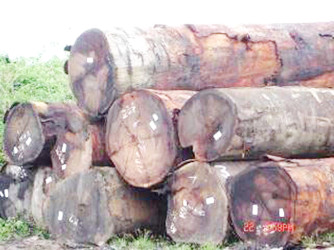The performance of the local timber industry in 2015 reflected a significant decline in both production and export sales, mirroring the myriad challenges facing the industry.
Comparative figures compiled by the Guyana Forestry Commission point to a more than US$8 million reduction in export sales last year when compared with 2014. More than that, leaving aside an infinitesimal increase in fuelwood sales, all of the other categories of timber exports realized less foreign exchange earnings last year than in 2014.
According to the GFC figures, timber exports for last year totalled US$45,627,725 compared with $54,100,000 in 2014.

As is customary, the sale of logs again led the way last year with earnings totalling US$20,669,302, though that figure lagged behind 2014 earnings of US$24,500.000. Earnings from primary timber for 2015 slipped to US$18,013,447 from US$20,300,000 in 2014. Round wood sales fetched US$2,122.289 last year compared with US$4,100,000 in 2014, while splitwood sales realized $2,089,193 last year compared with $2,100,000 in 2014. Plywood and veneer exports earned US$1,940,882 last year compared with US$2,600,000 the previous year. The GFC’s figures also indicate that last year, “added value products fetched US$457,439 compared with US$200,000 the previous year.”
Significantly reduced overseas earnings from the timber sector last year was reflective of a projected overall drop in production in the forestry sector. In the case of logs, the GFC said production had been projected to drop from 406,400 cubic metres in 2014 to 346,000 cubic metres last year. Plywood production for 2015 had also been expected to slip, down to 34,000 cubic metres from 41,000 cubic metres in 2014.
The volume of primary lumber production, meanwhile, was expected to rise from 67,100 cubic metres in 2014 to 70,000 cubic metres last year. Overall timber production for last year was expected to slip marginally down to 502,043 from 572,110 in 2014.
In recent years, the forestry sector has been plagued by controversy associated chiefly with the dichotomy between the imperative of exploiting the country’s forestry resources on the one hand and the imposition of harvesting controls that reflect a mindfulness of the country’s commitment to the preservation of the forests. ‘Territorial’ controversy has also arisen between the timber and gold mining sectors over exploitation privileges.
On the export side, the relatively recent significant presence of expatriate – notably Chinese – presence in the timber industry has triggered concern over increased harvesting, export of logs and the consequent reduced potential of the value-added prospects of the sector.




